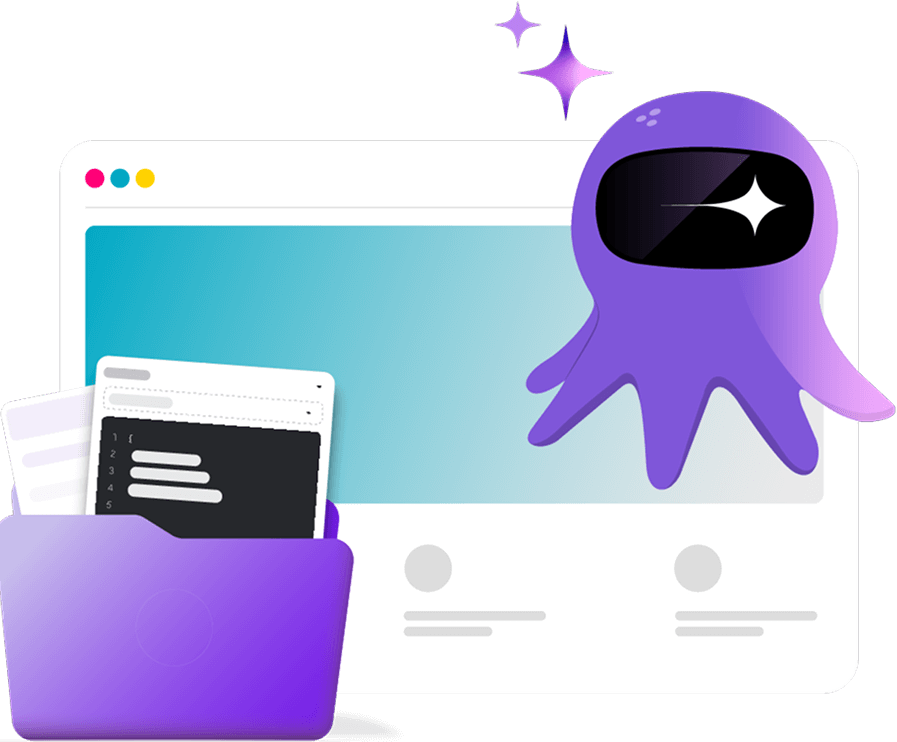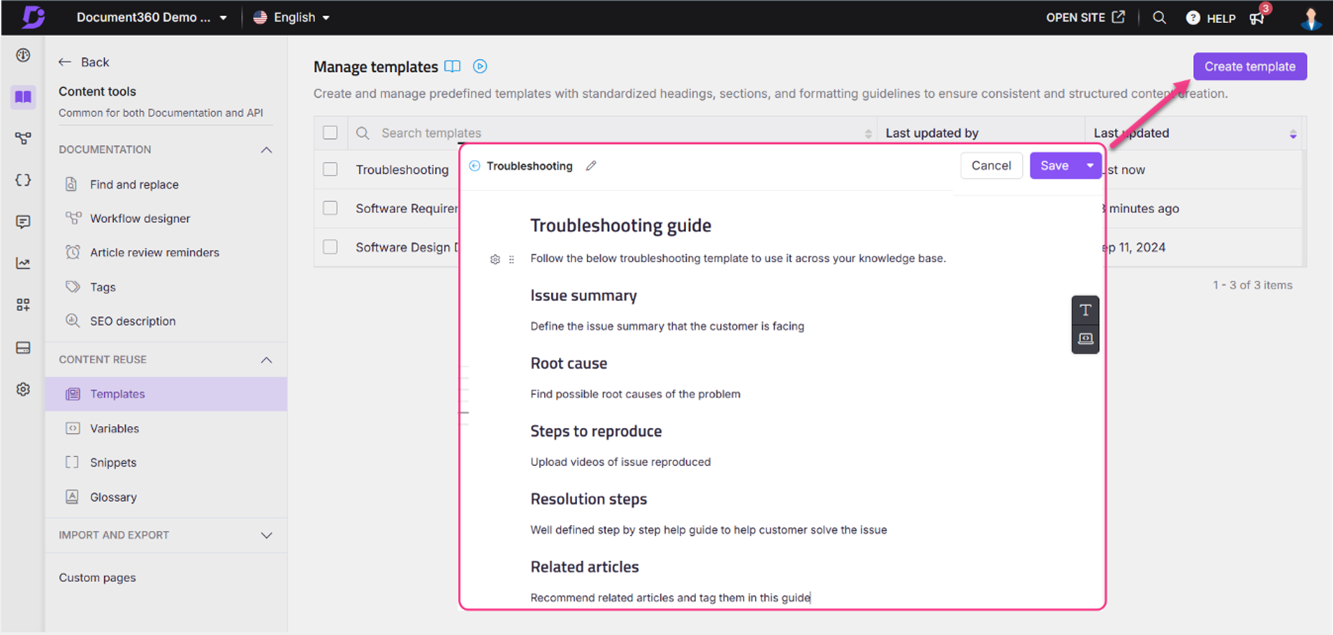Managing a knowledge base that contains a huge amount of information can be challenging. Whether it’s policies, security details, settings, or addresses, each time a change is made, it becomes a tedious task to update the information across the entire documentation. But have you ever thought how easy it would be if you could change the content in just one place and every other instance gets updated too?
Yes! That’s where content reuse comes into play. By utilizing a content reuse strategy with reusable components such as variables, snippets, glossaries, and templates, you can streamline your documentation process, reduce repetitive tasks, save time, and maintain consistency throughout.
What Is Content Reuse?
Content reuse is the practice of using repeated content blocks or terms. They can be policies, definitions, disclaimers, or global terms. This helps you maintain consistent communication of information. With a change in a single location, you can update multiple instances of repetitive information.
Starting from single terms to large content blocks, the content reuse strategy helps you with:
- Accuracy – Reduces the chances of errors or outdated information. Also reduces the chances of information mismatch – either this or consistency.
- Efficiency – Helps you reduce copy-paste time while using repetitive content.
- Consistency – Maintains uniformity of information across the knowledge base.
Let’s explore the content reuse strategy elements offered by Document360:
Using Variables for Short Form Use
Variables are ideal to use for a recurring set of words, such as:
- Email addresses
- Product names
- Universally used terms or internal terms specific to a product or a company
- Contact details
- Company tagline
Instead of updating such details manually whenever a change is made, you can use a variable. By simply updating the variable once, the changes will be reflected across all instances. This helps writers save hours of time and ensures no impact area is left unchanged during updates.
Example variables:
✅ You can use a variable to store the Customer Support email address and reuse it wherever you mention it in the knowledge base. For example, if you have around 10+ troubleshooting guides where the support contact is provided, using the variable will make your task easier if you have made a change in the contact.
✅ Suppose you have used your company’s tagline, say, “Empowering knowledge worldwide,” across your About us, Footer, or Press release pages. Saving it as a variable will help you make changes throughout with an update in a single location, in case of branding changes.

Using Snippets for Long Form Content Reuse
Snippets come in great use when large blocks of content are reused in multiple places, such as:
- Company or security policies
- Product descriptions
- Terms and conditions
- Brand logos or product images
Snippets allow you to save and reuse text, images, and HTML blocks across your documentation. Just like variables, snippets reflect changes throughout their usage with a change in a single location.
Example snippets:
✅ If you have the company’s privacy policy added to a bunch of product-related articles, you can store and reuse the content as a snippet. If any changes are made to the policy, updating the snippet will automatically reflect the change in all instances.
✅ If you have your company’s address added to sales, marketing pages, or across 20+ instances, having it saved as a snippet will make your job easier when the company moves to a new location or there is any change in the address. This will ensure accuracy and also save your time!

Streamline your documentation with content reuse and keep your knowledge base consistent.
Book A Demo
Using Glossary for Consistent Definitions and Better SEO
Glossary terms are an essential element to use when your content includes product-specific terms, technical jargon, acronyms, or terms specific to some description, such as:
- Articles and category pages
- Terms across multiple languages
- Onboarding content
- Compliance or legal content
- Product guides
- Developer documentation
This helps users understand terms without any reading disturbances. Readers can hover over any glossary term to view the definition without leaving the page. You can define a term once and reuse it. Glossaries also help optimize search engine visibility by relating relevant keywords with clear definitions.
Example glossaries:
✅ If you have to mention acronyms such as “GDPR” in multiple legal and privacy-compliant articles, instead of defining it every time the term appears, you can define it once in the glossary. Readers can just hover over the term and understand it without any interruption in their reading flow.
✅ If you are drafting a developer documentation that includes the use of the term “API” in multiple instances, you can define it once in the glossary. This would be helpful to both internal non-tech team members and technical readers, without cluttering the content with repeated definitions.

Using Templates to Standardize Structure and Content Creation
While elements like Variables, Snippets, and Glossaries help in reusing content, Templates come in use as writing blueprints when you wish to preserve and reuse a structure. These are handy when maintaining a consistent format, tone, and layout across your documentation, such as in:
- How-to-guides
- Troubleshooting guides
- FAQs
- Release notes
- Product specifications
Templates help maintain a professional knowledge base by following a consistent structure. You only need to load and use pre-built templates, then start editing, thereby saving hours of time.
Example templates:
✅ You can create and save a Troubleshooting template with the headings below. This is helpful when you follow a similar structure for every guide.
- Issue summary
- Root cause
- Steps to reproduce
- Resolution steps
- Related articles
✅ You can draft and save a Step-by-step guide template with the sample headings below. This will help reduce the time spent drafting the same structure from scratch for every guide.
- Use case
- Accessing
- Editing
- Managing
- Deleting
- FAQs

Best Practices to Follow for Better Content Reuse
Below are a few tips to follow that will help you use content reuse tools in a better way:
- Always use meaningful names for the reusable elements.
- Avoid spaces in snippet and variable names. Instead, use hyphens or underscores.
- Run regular checks on the elements and their content to ensure accuracy and up-to-date information.
- Give clear definitions of glossary terms so that readers are educated right on first read.
- Use well-structured templates with clearly defined subheadings so that they match the context.
Conclusion: The Smarter the Work, the Less the Effort
Content reuse has a major impact on productivity, accuracy, and uniformity in the knowledge base. Whether you are a technical writer, product manager, or support specialist, this content reuse strategy offering tools like Variables, Snippets, Glossaries, and Templates can scale up your documentation. This benefits you with easier knowledge base management, professional information delivery, and improved search engine optimization.
Ready to transform your knowledge base with our content reuse strategy? Explore Document360!





 –
– 

